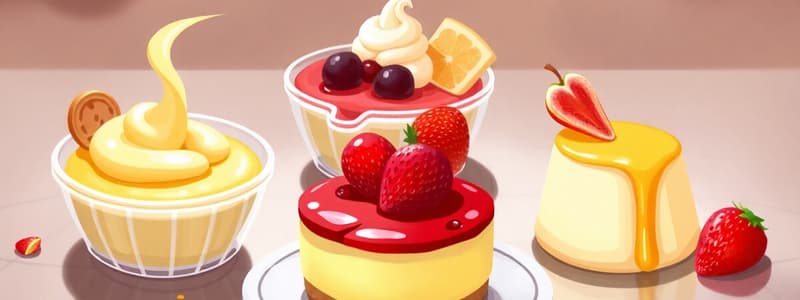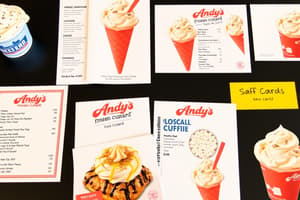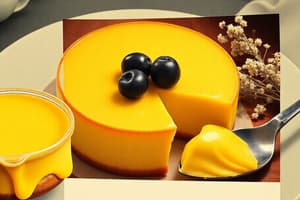Podcast
Questions and Answers
What happens to proteins in a liquid when it begins to boil?
What happens to proteins in a liquid when it begins to boil?
- They cause the liquid to evaporate
- They dissolve completely
- They begin to gelatinize (correct)
- They form a solid layer on top
Which of the following is NOT a food high in starch?
Which of the following is NOT a food high in starch?
- Tapioca
- Lettuce (correct)
- Potatoes
- Cassava
What is the first step to thicken a liquid with starch?
What is the first step to thicken a liquid with starch?
- Stir starch with a little water (correct)
- Add starch directly to the boiling liquid
- Cool the liquid down before adding the starch
- Increase the heat to maximum before adding starch
How long should you continue to boil and stir the liquid after adding starch?
How long should you continue to boil and stir the liquid after adding starch?
What type of cheese is used in New York cheesecake?
What type of cheese is used in New York cheesecake?
What is a common cause of cheesecake cracking during baking?
What is a common cause of cheesecake cracking during baking?
What is the correct procedure for tempering eggs?
What is the correct procedure for tempering eggs?
Which type of cheesecake tends to have a lighter texture?
Which type of cheesecake tends to have a lighter texture?
What happens if a cheesecake is overbaked?
What happens if a cheesecake is overbaked?
What is a necessary step when using starches to thicken a liquid?
What is a necessary step when using starches to thicken a liquid?
What does 'nappe' refer to in the context of cooking?
What does 'nappe' refer to in the context of cooking?
What primarily influences the consistency of custards?
What primarily influences the consistency of custards?
What defines boiled custards compared to stirred custards?
What defines boiled custards compared to stirred custards?
Which ingredient can be added to custards to alter the texture?
Which ingredient can be added to custards to alter the texture?
When preparing stirred custards, what is essential to prevent the eggs from scrambling?
When preparing stirred custards, what is essential to prevent the eggs from scrambling?
What is the purpose of proofing the yeast when making bread?
What is the purpose of proofing the yeast when making bread?
What temperature should the liquid be when proofing the yeast?
What temperature should the liquid be when proofing the yeast?
How long should the dough knead for optimal development?
How long should the dough knead for optimal development?
When is the dough ready after the first rise?
When is the dough ready after the first rise?
What should be done to the bowl used for the first rising of the dough?
What should be done to the bowl used for the first rising of the dough?
Which of the following types of cakes primarily utilize the creaming method?
Which of the following types of cakes primarily utilize the creaming method?
What is the main purpose of preheating the oven before baking cakes?
What is the main purpose of preheating the oven before baking cakes?
What essential component must be achieved for the egg foam method before folding into the batter?
What essential component must be achieved for the egg foam method before folding into the batter?
Why is it important to prepare the pans before mixing the cake batter?
Why is it important to prepare the pans before mixing the cake batter?
What is the texture of a cake made using the creaming method?
What is the texture of a cake made using the creaming method?
What is the process of gently combining whipped egg whites into a batter called?
What is the process of gently combining whipped egg whites into a batter called?
What is a potential consequence of overmixing the batter after folding in the egg whites?
What is a potential consequence of overmixing the batter after folding in the egg whites?
At what level should cake pans be filled to ensure proper rising?
At what level should cake pans be filled to ensure proper rising?
Flashcards
Custard
Custard
A creamy mixture made by thickening a liquid with egg proteins. The consistency depends on the ratio of eggs to liquid, whether yolks or whole eggs are used, and the type of liquid. Starches or flour can also be added.
Stirred Custards
Stirred Custards
Custards cooked on the stovetop while constantly stirring to prevent eggs from scrambling. They can be used as sauces, dessert components, or enjoyed alone.
Sabayon
Sabayon
A light, airy custard made with egg yolks and sugar, often flavored with wine or brandy.
Lemon Curd
Lemon Curd
Signup and view all the flashcards
Crème Anglaise
Crème Anglaise
Signup and view all the flashcards
Boiled Custards
Boiled Custards
Signup and view all the flashcards
Pastry Cream
Pastry Cream
Signup and view all the flashcards
Baked custards
Baked custards
Signup and view all the flashcards
What is starch?
What is starch?
Signup and view all the flashcards
How to thicken a liquid with starch
How to thicken a liquid with starch
Signup and view all the flashcards
How starch thickens a liquid
How starch thickens a liquid
Signup and view all the flashcards
Flour as a thickener
Flour as a thickener
Signup and view all the flashcards
Other common starches
Other common starches
Signup and view all the flashcards
Italian Cheesecake
Italian Cheesecake
Signup and view all the flashcards
New York Cheesecake
New York Cheesecake
Signup and view all the flashcards
Tempering Eggs
Tempering Eggs
Signup and view all the flashcards
Nappe
Nappe
Signup and view all the flashcards
Starch
Starch
Signup and view all the flashcards
Thickener
Thickener
Signup and view all the flashcards
Cheesecake
Cheesecake
Signup and view all the flashcards
A Thickener Mixture
A Thickener Mixture
Signup and view all the flashcards
What is proofing yeast?
What is proofing yeast?
Signup and view all the flashcards
What is kneading?
What is kneading?
Signup and view all the flashcards
What is the first rising?
What is the first rising?
Signup and view all the flashcards
What is the 'indent test'?
What is the 'indent test'?
Signup and view all the flashcards
What is punching down the dough?
What is punching down the dough?
Signup and view all the flashcards
Creaming Method
Creaming Method
Signup and view all the flashcards
Egg Foam Method
Egg Foam Method
Signup and view all the flashcards
Folding
Folding
Signup and view all the flashcards
Soft Peaks
Soft Peaks
Signup and view all the flashcards
Firm Peaks
Firm Peaks
Signup and view all the flashcards
Stiff Peaks
Stiff Peaks
Signup and view all the flashcards
Preparing Cake Pans
Preparing Cake Pans
Signup and view all the flashcards
Baking Cakes in the Middle of the Oven
Baking Cakes in the Middle of the Oven
Signup and view all the flashcards
Study Notes
Custards
- Custards are liquids thickened by egg protein coagulation.
- Consistency depends on the ratio of eggs to liquid, whether whole eggs or just yolks are used, and the type of liquid.
- Starches or flours can also be added.
- Custards can be stirred, boiled, or baked.
Types of Custards
Stirred Custards
- Cooked on the stovetop, constantly stirred to prevent eggs from scrambling.
- Can be served as a dessert sauce, part of a complex dessert or eaten alone.
- Common examples include vanilla custard sauce (crème anglaise), sabayon, and curd fillings.
Boiled Custards
- Cooked on the stovetop using eggs and a thickener like cornstarch or flour.
- Must be brought to a boil.
- Common examples include pudding and pastry cream.
Baked Custards
- Cooked in the oven.
- Flavor and texture depend on the quantity and type of ingredients.
- Common examples include cheesecake, crème caramel, flan, crème brûlée, and bread pudding.
Cheesecakes
- Two main types are Italian and New York.
- New York cheesecake uses cream cheese, resulting in a rich, heavy, and dense texture.
- Italian cheesecake uses ricotta cheese, providing a lighter texture and consistency.
Cheesecake Issues
- Overmixing: Introduces air bubbles which expand and burst during baking, causing cracking.
- Cold Ingredients: Cold ingredients don't cream effectively, resulting in uneven baking.
- High Oven Temperature: High temperatures cause proteins to coagulate quickly, leading to cracking.
- Overbaking: Custards, including cheesecake, can be dry and cracked if overcooked.
- Incorrect Ratio of Ingredients: Imbalances in the ratios of ingredients in the cheesecake batter can cause cracking or sinking.
- Incorrect Baking Time: Baking time needs to be adjusted depending on the size and type of cheesecake.
Tempering
- Slowly cooking eggs to prevent curdling or scrambling.
- Heat liquid and slowly pour into eggs, whisking constantly.
- Return mixture to a pot, cook over medium-low heat and stir constantly until the mixture reaches nappe consistency.
- Remove from heat and strain.
- Nappe consistency is thick enough to coat the back of a spoon.
Thickeners
- Thickeners, such as starches or flours, are added to liquids to create a firmer consistency.
- Starches include cornstarch, arrowroot, and others.
- When using starches or flours, bring liquid to a boil before adding the thickener.
- This gelatinizes protein, enabling stabilization and thickening.
- Flour, typically all-purpose, is another common thickener.
Starch
- Starch comes from plant-based foods high in starch (e.g., corn, potatoes, tapioca, beans, rice).
- Different starches work in different ways.
Thicken Sauce with Cornstarch
- Stir starch with a little water (to prevent clumping)
- Pour into boiling liquid
- Continue stirring for 1-2 minutes.
Studying That Suits You
Use AI to generate personalized quizzes and flashcards to suit your learning preferences.




